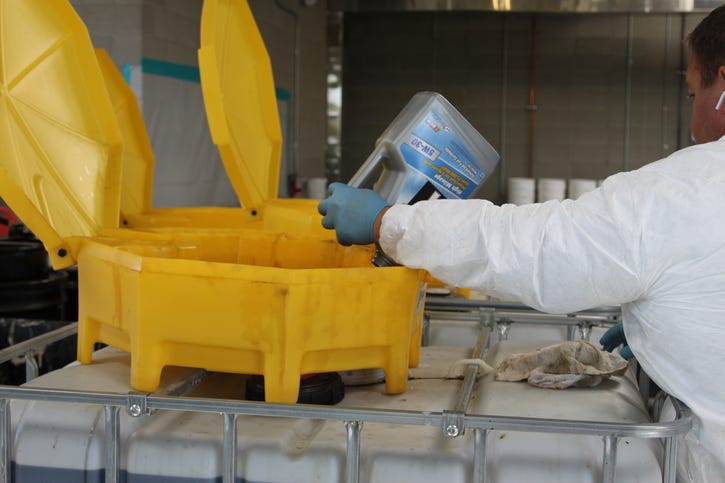Mesa, Ariz., Launches Household Hazardous Waste Facility
In addition to processing HHW, the facility houses a swap shop where residents can pick up materials like cleaners, propane tanks, paint and oil.

Mesa, Ariz.’s household hazardous waste (HHW) collection events always drew a crowd, with more than 1,000 people waiting in line for an hour or more to drop off unwanted paints, automotive fluids, pesticides, aerosol cans, light bulbs, batteries, tires electronics, among other items. Realizing that the four annual events weren’t enough, the city just launched a year-round facility open to its 130,000 residents 20 hours a week.
The new operation is in a 7,000-square-foot building, on the same property where some of the events were held, making it a familiar locale to the community. Besides processing HHW, the building houses a swap shop where people can pick up free, unused or lightly used materials like cleaners, propane tanks, paint and oil.
“We run this facility because we want to focus on reuse and recovery of materials rather than have to ship them out to be disposed of,” says Lauren Whittaker, facility manager of the new facility.
The most collected item is latex paint, which gets remixed and given away in 5-gallon buckets. Mesa is looking for recycling partners to send the relatively small volume that can’t be remixed.
Replacing the quarterly drop-offs with this permanent facility will improve logistics and the bottom line, anticipates Scott Bouchie, environmental manager and sustainability director for the city of Mesa.
“Before, at the end of the day, everything had to go, and there was no time to neatly package. We were busy trying to get people through quickly and safely. But now, we have full-time staff that can package, bulk and store more efficiently. So, we can do it for less cost per resident, per vehicle and per gallon. We can increase diversion and serve more residents,” he says.

The program is funded through a portion of Mesa’s Green and Clean fee, which is added to residents’ solid waste utility bills. The fee will pay for all ongoing expenses of the new, permanent operation.
While the idea is to turn the campus into a waste-to-resource facility, some virgin materials come in, too. For instance, people drop off surplus paint that is a custom color and nonreturnable. They bring in new automotive fluids or mini propane tanks that they just want to be done with.
The staff unloads residents’ vehicles to keep lines moving, sorts materials and places them in sections by category. The staff then bulks compatible materials together and sends them for recycling, reuse, fuel blending, incineration or another process or purpose. The staff also conducts simple lab tests if needed when packages are unmarked to avoid mixing incompatible materials when bulking.
Residents bring materials in plastic totes or sturdy cardboard. They are to keep what they drop off in original containers when possible and otherwise label them.
To ensure people know what to do, the city updated its webpage with location, hours of operation, accepted and unaccepted items and daily limits. An online video shows how to prepare for visits, such as how to separate items.
“We worked closely with the Gilbert [Arizona] household facility to design the whole program, both from a construction point and on how to operate the facility. We got ideas from Gilbert, like the swap shop. We think a lot will stay in this shop,” says Whittaker.
The cities of Tempe and Chandler also have HHW drop-off and recycling facilities.
Tempe takes paint, oil, batteries, antifreeze, pool chemicals, e-waste, textiles, tires, scrap metal—just about anything residents would have in their garage or shed.
“What we learned is you have to expand by taking more and more recyclable items, not just household hazardous waste. And we learned if the process is easy, people are more likely to use the service and provide positive feedback to friends and family,” says David Tavares, Tempe’s hazardous waste and compliance supervisor.
“What I would tell anyone thinking of opening a similar facility is, if you build it, residents will come,” he adds. “Build it big enough so you can expand the waste streams you take as time passes. You won’t be taking just batteries and tires; you’ll be taking more items that come through drop-offs at your facility, and you’ll need the space to handle them.
“Remember, the work you do decreases the amount of landfill space you’re using,” says Tavares. “Plus, you are protecting surface water and keeping water treatment plants from receiving unwanted chemical contaminants.”
About the Author
You May Also Like




